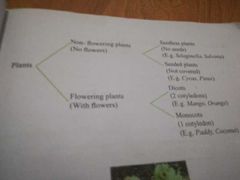![]()
![]()
![]()
Use LEFT and RIGHT arrow keys to navigate between flashcards;
Use UP and DOWN arrow keys to flip the card;
H to show hint;
A reads text to speech;
29 Cards in this Set
- Front
- Back
|
Kingdom protista |
*possess a eukaryotic cellular organization*either multicellular or unicellular without a tissue differentiation*live in environments associated with water*mostly photosynthetic*some are heterotrophic*algae and protozoans belong to this group |
|
|
Useful effects of algae |
*Used in extraction of alginic acid to make ice cream *algae act as primary producers in food chains of aquatic environments * cause diseases ex- malaria,amoebiosis,skeeping sickness |
|
|
Kingdom fungi |
*Kingdom of organisms with chitinous Cell wall and a eukaryotic cellular organization. * either multicellular or unicellular |
|
|
Uses of fungi |
*to produce antibiotics ex- penicillin *to decompose dead bodies and structures |
|
|
Structure of bacteria |
*Unicellular,microscopic,prokaryotic organisms |
|
|
Shape of bacteria and cyanobacteria |
*Coma shaped,spherical,spiral,rod-shaped are the different shapes of bacteria *cyanobacteria exists as single cells, branched or unbranched filaments |
|
|
Nutrition of bacteria |
*Mostly heterotrophic *cyanobacteria are autotropic |
|
|
Reproduction of bacteria |
Mostly asexual reproduction. budding and fragmentation -cyanobacteria Binary fission- bacteria |
|
|
Distribution of bacteria |
In soil,air,water and bodies of organisms. |
|
|
Structure of protista |
*Mostly microscopic,but bodies of some red algae can be seen *eukaryotic *mostly unicellular *some are multicellular without a tissue differentiation |
|
|
Shape of protista |
Horse shoe shaped,leaf shaped |
|
|
Nutrition of protista |
Algae are phototropic but unicellular animals (protozoans) are heterotropic |
|
|
Reproduction of protista |
*Reproduce asexually(fragmentation,binary fission,spore production) |
|
|
Distribution of protista |
Marine,fresh water,damp soil |
|
|
Structure of fungi |
*Mostly microscopic*but some reproductive structures can be seen with the naked eye.*eukaryotic organisms*some are multicellular some are unicellular* they exist as multicellular mycellium*no tissue differentiation |
|
|
Shape of fungi |
Single spherical cells or fungi mycelium |
|
|
Nutrition of fungi |
*Mostly heterotrophic *some obtain nutrition as saprophytic organisms |
|
|
Reproduction of fungi |
Mostly reproduce by asexual spores |
|
|
Distribution of fungi |
Live in organic matter and living body |
|
|
Kingdom plantae |

Categorization of kingdom plantae |
|
|
Non floweing seedless plants |
Marchantia,salvinia,drynaria |
|
|
Structure of non-flowering seedless plants |
*Small to large sized plants. *Some plants lack a tissue differentiation *those have no stems,leaves,roots And known as thallus *some possess differentiated vascular tissues *they possess stems,leaves,roots |
|
|
Shape of non-flowering seedless plants |
Thalloid body or small fern type |
|
|
Nutrition of non-flowering seedless plants |
*All are autotrophic photosynthetic. *some are epiphytes |
|
|
Reproduction of non-flowering seedless plants |
*Asexual reproduction by fragmentation of vegetative parts and spores. *perform sexual reproduction too. |
|
|
Distribution of non flowering seedless plants |
Terrestrial environments with low sunlight,shady and wet places |
|
|
Non-flowering seed plants(gymnosperms) |
*Seeds of these plants are not covered by fruits therefore they're naked. Ex- cycas,pinus |
|
|
Structure of non-flowering seed plants |
*True tissue differentiation is present *possess vascular tissues *stems,leaves,roots are present |
|
|
Shape of non-flowering seed plants |
*Larger in size *most are trees *straight woody stems *some are shrubs |

